Optimizing Contracting Strategies
In order to manage successfully a project, certain perspectives need to be covered.
- Purpose
- People
- Complexity
- Uncertainty
This article briefly explains the tools that can be used to analyze each perspective.
Contents |
Purpose
Vision Statement
A project vision statement is a short description of the whole project. This statement should be simple, specific and inspiring for both the team members and stakeholders. Eventually, a well-defined vision statement can help the project manager lead the project in the right direction and help to keep the team motivated and inspired. If the vision statement is inspirational, it can help to keep the stakeholders more committed to the project. In total the vision statement, if done properly, can enhance the performance for the project. In this manner, it is a powerful tool for creating a guideline for the project, but the limitations are also big since it gives no concrete plan for the project and it should be explained in a clear way in order to gain the benefits of the tool.
Creating a project vision statement, it should be clear what the team wants to accomplish by completing the project. Therefore the vision statement should highlight the goal in a couple of sentences. The vision statement is something every organization or project could benefit from.
How to: Looking at the PMI standard, it is well known that the project management processes are divided into 5 different groups[1]:
- Initiating
- Planning
- Executing
- Monitoring
- Closing
The vision statement will normally take place in the first phase, Initiation, in order for the project to be defined with a goal[2]. This will help decrease the confusion of the project inside the team since the idea is to create a common goal and stop team members from thinking about all sorts of different goals. Creating a vision statement is a good foundation for the strategy, and it can be done in 6 steps[3]:
SMART goals
SMART is a tool for setting a goal which is divided into 5 steps[4]:
1. Specific (simple, sensible, significant) 2. Measurable (meaningful, motivating) 3. Achievable (agreed, attainable) 4. Relevant (reasonable, realistic and resourced, result-based) 5. Time-bound (time-based, time-limited, time/cost limited, timely, time-sensitive)
The SMART approach is used to define, develop, and achieve your goals.
Firstly, the specifics should be defined and to answer these “W” questions should be used.
Could be:
What, why, who, where or which
Secondly, the measures should be defined in order for the manager to track the progress and keep the team motivated on the process. The measurables can be found with questions like:
How much, How many or How will I know when it is accomplished?
Thirdly, making the goals achievable and realistic in order to become successful. In order to answer if the goal is realistic or not the following questions could be answered:
How can I accomplish this goal or How realistic is the goal (based on constraints)?
Fourthly, the relevance of the goal and how to retain control of them in order to move you and everyone else in the same direction. If it is possible to say “YES” to the following questions, you are heading in the right direction:
- Does this seem worthwhile?
- Is this the right time?
- Does this match our other efforts/needs?
- Am I the right person to reach this goal?
- Is it applicable in the current socio-economic environment?
Lastly, the goal needs to be time-bound. If the project does not have a deadline the team cannot work towards a common goal at the same pace. To answer this time-relevant questions should be answered, like:
What can I do six months from now?, What can I do six weeks from now? What can I do today?
Using SMART will clarify and set focus on the relevant tasks in the project. SMART is easy to use for anyone, but it is said not to be so flexible and therefore not good for long term projects.
Project Charter
A project charter is the statement of scope, objectives, and people participating in the project[5].
It is used to get an understanding of the essence of the project, goals to be achieved, the objectives and how to reach all of the mentioned.
Also, it helps to provide a common understanding of the project by explaining the understanding of the project to both managers, stakeholders, sponsors and so on. It should communicate the responsibilities of every manager, stakeholder or sponsor engaged in the project.
When the project charter is completed a lot more time should be spent going into depth with some of the things that became clear doing the charter. It could be risks, costs, benefits, stakeholders, and constrains[5].
A project charter is a good tool for selling the project to sponsors/stakeholders since it should give a crystal clear picture of what, how and why the project is engaged.
Finally, it can be used as a point of reference if any disagreements were to arise during the project, which can be used throughout the whole project.
The project charter is powerful when deciding on the direction of the project according to the organizational strategy and goals since the connection between the project and organizational goals should be approached where possible compliances might become clear[6]. It is, therefore, an important tool for the company since it can help to pick the right projects for the company.
Some limitations for the project charter are risks, an elaborate risk analysis is recommended in extension to the charter. Secondly, if the project charter has a solution, but it is not good enough, it might be time-consuming, which will end up delaying the project.
Business Case
Business Case is a tool that evaluates whether or not the project is worth investing in from the company perspective. It is targeted at management and is a tool to obtain management commitment and approval for the investment. It has to be defined and developed within the initial phase of a project and has to be maintained once the project progresses. Payback period analysis and Net Present Value (NPV) analysis are mostly used for the financial appraisal. Furthermore the business case investigates in:
- Reasons
- Options
- Benefits and dis-benefits
- Timescale
- Cost
- Major Risks
- Opportunities
For further information refer to the following DTU wiki [7].
Key Performance Indicators (KPI)
This tool represents a quantitative measurement of a company's efficiency. It evaluates their success at achieving key business objectives and reaching specific targets. KPI can be applied of different level, depending on the process they focus on. These assessments frequently help identify potential improvements, which then often lead to initiatives to improve performance.[8]
[9] These indicators can be either quantitative or qualitative:
- They are considered quantitative when numerical and objective facts are gathered and measured against a standard.
- They are qualitative when values that are presented as numbers or text representing opinions or personal feelings are compared to equivalent measurements.
People
Value Proposition Canvas [10]
The value proposition canvas is a tool that helps to ensure that the solution considers the needs, values, and pains of the customers. This canvas analyses:
- Customer segment:
Customer job(s): The customer job(s) assess what the customer wants to do, which actions or tasks does the customer or user want to perform.
Pains: This can be a result of competitors lacking the necessary capabilities to offer a proper product or service. It can also be a result of users not having access to any products or services to fulfill their customer job. The project manager must acknowledge these customer pains, in order to identify the benefits project outcomes need to incorporate.
Gains: Unlike pains, gains are not factors that are clear for the user. These are factors that the user is not necessarily expecting of a product or service but are extra benefits supplied.
- Value proposition:
Products & Services: Outlines the products and services the project outcome is built around.
Pain relievers: ways of removing the customer/user’s pains.
Gain Creators: deliverables creating the extra gains for the customer/user.
For further information refer to the following DTU wiki [11].
Maslow hierarchy of needs [12]
Maslow proposes five levels of needs ordered in a hierarchy of needs. Once the requirements of a level are met on an on-going basis, their needs move to the next level up.
This theory can be extrapolated to the project management environment, to come to the conclusion that:
- Until the basic needs are met, an individual will not be looking for higher-order needs.
- Motivation can be provided through an individual pursuing as yet unmet needs.
For further information refer to the following DTU wiki link.
Stakeholder analysis/ mapping
Stakeholders can be described as a individual, group or even an organization. These stakeholders are affected and interested in a decision, action or the output of a project. Therefore, stakeholders have to be defined, analyzed and displayed to ensure that all relevant stakeholders are taken into account and receive the best possible output.[13]
A power-interest matrix can be used to display and allocate stakeholders regarding there power and interest in a project. Moreover, the relations between the stakeholders can be displayed. In complexe projects often more than one matrix is used, because multiple stakeholders are entering and leaving the project during the process.
To analyze and categorize the importance of stakeholders multiple ways can be used and can be found in detailed wiki article link.
Complexity
Complexity happens when too many parts come together and it becomes difficult to structure and organize the activities, portfolio and cost flows. In order to manage the situation, the first step to take would be trying to break down the main tasks. Once smaller tasks are gathered, it will be easier to focus on their complexity individually. It is convenient to break down each task as much as possible so even if this will create many starts treating them as smaller individual tasks.
The following tools are used to break down the situation.
Contracting and procurement
[14] Contracting refers to the process of creating an agreement between multiple parties that is mutually binding. The arrangement is aimed to provide the so-called buyer with a product or service that the seller offers.
[15] Procurement encompasses all the activities through which products or services are acquired from external members to the employee base. Amongst the responsibilities of Project Procurement Management (PPM), is the process to identify which of various alternatives fits best a purpose and how to complete its purchase or hiring most efficiently. The latter is where a contract is put together, making contracting one of the most important components of PPM.
Gantt Chart in Project Management [16]
A Gantt Chart is a timeline management tool to illustrate how a project will be running. Thanks to the tool it is possible to view individual tasks, their durations and the sequencing of these tasks. Also, it is very useful as it illustrates the overall view of the timeline of the project and the expected completion dates of each phase.
One of the several benefits of using Gantt Charts in Project Management is the possibility to run the project with greater efficiency with improved either cost and time outcomes Basically, a Gantt chart provides a graphical illustration of a schedule that helps to plan, coordinate, and track specific tasks in a project.
Thus, in order to be able to build a valid model these are the steps that must be taken:
Step 1: Identify Essential Tasks
Step 2: Identify Task Relationships: These dependent activities are called "sequential" or "linear" tasks. Other tasks will be "parallel”.
Step 3: Input Activities Into Software Or a Template: there are many programs that help us build Gantt chart like Microsoft Project, for instance.
Step 4: Chart Progress: the chart needs to be updated in order to reflect changes as soon as they occur
Stage Gate Process [17]

The tool divides the project into several information-gathering stages, where each stage is separated by gates. It is mainly used for the evaluation of the project. Gates can be considered as milestones, since several goals need to be achieved by each gate, after which next stage can start. Each gate has a gate meeting where the project group gathers and needs to agree on the same conclusion about inputs/deliverables, criteria and outputs. Content of each stage and the gate goals are project specific and have to defined by the company/project group within the planning phase of a project.
Cooper [18] has defined the following 5 stages, but states that a stage gate process can include 4-8 stages after the preferences of the company:
Gate 1: Preliminary Assessment
Gate 2: Definition
Gate 3: Development
Gate 4: Validation
Gate 5: Commercialization
The method is often used in combination with other project management tools like Gantt Chart, where resource availability, project-related risks or costs and benefits of the project are analyzed.
Benefit Mapping
Benefit mapping can be seen as one of the key elements, that support organisations to identify benefits and criteria for organisational aims and objectives in benefits realisation management. [19]
The tool is used to receive a visual presentation to evaluate a specific business case by displaying efforts and gains. The visual presentation displays the complete life-cycle. Therefore the decision maker can use the tool to evaluate why a potential project or program should be implement or not.
Theses structured methodology is using the collection of knowledge from a number of different people. In a so called benefit workshops benefits can be gathered and discussed. Thereby, a various number of benefits are collected which can be classified e.g. in tangible or intangible. [20]
The investigation and involvement of stakeholders that are effected by the benefit map is one important part for a successful benefit map. Therefore, stakeholder should be considered from the beginning and involved in all process steps. [21]
For further information refer to the following DTU wiki link.
Uncertainty
Recovery Project Management [22]
Project failure can happen to any project. Statistics report that only 52% of completed projects meet their proposed functionality.
There is a five steps approach to recovering projects that are failing. This plan works to provide structure and results for the Recovery Project Manager (individual person from outside the project and who then is not the Project Manager) and his or her team. The process begins by focusing on determining the current real status of the project and the changes that need to be made in people, the product or service specifications of the project, and project management processes in order to improve performance. The most critical steps to be taken include:
Defining the Charter
- Define the mission with the sponsor
- Understand the project history and sensitivities
- Establish initial project team contact
- Determine the assessment approach
- Complete the charter and obtain approval
Developing the Assessment Plan that is:
- Realistic
- Allows an assessment in short time
- Ensures accurate findings
- Minimizes team distractions
Conducting the Assessment on three main areas:
- Determining the true current status of the project
- Identifying the major threats, opportunities and problems for the project moving forward
- Establishing an extended team for the recovery effort
Developing the Recovery Plan
- Focus on building everyone's morale
- Deal directly with personnel problems
- Resolve serious leadership problems
- Add people to the project carefully
Conducting the Recovery
- In recovery, the “end state” needs to be in mind to start.
- The team monitors the execution of each milestone, it will conduct variance analysis at the end of each week.
This is an example or five key steps to go through project recovery but there are many other ways to manage failure in Projects. In the end, Project recovery is the effort and activities related to addressing troubled projects. In other words, the activities that leads to recognise that the project is troubled, after which brings to a decision point on whether or not to save that project.
The Triple Constraint in Project Management [23]
The Triple Constraint is often also known as The Project Management Triangle or the Iron Triangle. It represents the boundaries of scope, time, and cost that each project is to operate within, and how a variation in any of the three will forcefully have an effect upon the other two.
Scope, time and cost can also be seen not just as boundaries, but as priorities. It is the project management team's responsibility to assure overall contribution towards meeting the client's requirements, whether their focus is on scope, budget or deadline. This tool helps visualize the importance of each aspect of a project.
References
- ↑ PMI,What is Project Management? https://www.pmi.org/about/learn-about-pmi/what-is-project-management
- ↑ Project Vision Statement,My Management Guide? https://mymanagementguide.com/project-vision-statement/
- ↑ How To Write A Vision Statement,Why it is not enough? https://www.clearpointstrategy.com/how-to-write-a-vision-statement-why-that-isnt-enough/
- ↑ SMART Goals, Time Management Training From MindTools ... https://www.mindtools.com/pages/article/smart-goals.htm
- ↑ 5.0 5.1 Project Charter, Project Management Software https://www.projectmanager.com/blog/project-charter
- ↑ Project Charter, APPPM http://wiki.doing-projects.org/index.php/Project_Charter
- ↑ Business Case,Wikipedia http://wiki.doing-projects.org/index.php/Business_Case
- ↑ What is a KPI?, https://www.klipfolio.com/resources/articles/what-is-a-key-performance-indicator
- ↑ Performance indicator, Wikipedia, https://en.wikipedia.org/wiki/Performance_indicator
- ↑ Value Proposition Canvas,Wikipedia http://wiki.doing-projects.org/index.php/Value_Proposition_Canvas
- ↑ Value Proposition Canvas,Wikipedia http://wiki.doing-projects.org/index.php/Value_Proposition_Canvas
- ↑ Maslow hierarchy of needs,Wikipedia http://wiki.doing-projects.org/index.php/Maslow_hierarchy_of_needs
- ↑ 'Project Management Institute. (2010) A Guide to the Project Management Body of Knowledge (PMBOK Guide), Project Management Institute
- ↑ Contract, PROJECT MANAGEMENT KNOWLEDGE https://project-management-knowledge.com/definitions/c/contract/
- ↑ Procurement Management Plan, PROJECT MANAGEMENT KNOWLEDGE https://project-management-knowledge.com/definitions/p/procurement-management-plan/
- ↑ Gant Chart in Project Management, Mind Tools https://www.mindtools.com/pages/article/newPPM_03.htm
- ↑ Stage Gate Process,Wikipedia http://wiki.doing-projects.org/index.php/Stage-Gate_Process
- ↑ 18.0 18.1 Cooper, R.G.. "Winning At New Products", Addison-Wesley, 1986.
- ↑ Breese, R. "A unified view of benefits management/benefits realization management to be integrated into PMI standards", Sheffield Hallam University, 2016.
- ↑ "The Centre for Change Management", Benefits Management Course Material (2011). http://www.c4cm.co.uk/CourseMaterial/BensMgt/Benefits%20Management%20material.pdf
- ↑ Melton, T. Management Toolkit: The Basics for Project Success, Oxford: Elsevier Ltd, 2007.
- ↑ Recovery Project Management, PMI: https://www.pmi.org/learning/library/critical-steps-recovering-troubled-projects-7352
- ↑ Laura LaPrad. "Triple Constraint Theory in Project Management", TeamGantt, December 17, 2018.


